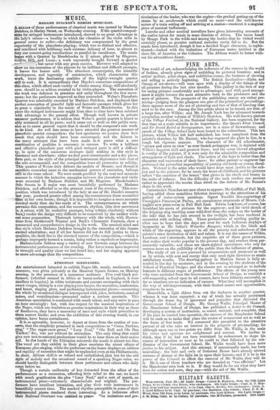ETHIOPIAN SERENADERS.
An entertainment intended to exhibit Negro life, music, sentiments, and manners, was given privately at the Hanover Square iooms, on Monday evening, in the presence of a numerous audience. Five coal-black per- formers, (whether sunned in Africa or burnt-corked in England, it were needless to inquire,) in white waistcoats and cravats contrasting with their start visages, sitting in a row playing two banjos, the accordion, tambourine, and bones, singing glees, and performing instrumental pieces—connecting the whole by occasional dialogue interspersed with jokes, imitations, comical noises, and ventriloquism—presented rather a curious spectacle. This American speculation is conducted with much talent, and may serve to pass an hour amusingly; bat, with due respect for the musical inspirations of the Negro, which are doubtless as genuine inspirations in their way as those of Beethoven, they have a monotony of tone and style which prescribes to them narrow limits; and even the exhibition of this evening would, in our opinion, have borne curtailment.
It is so agreeable, however, to depart at times from the routine of con- certs, that the simplicity promised in such compositions as " Come, Darkies, sing," " The sugar-cane green," " Lucy Neal," " Ole Bull and Ole Dan Tucker," &c., was not without its attraction. The only thing that could give new zest to national productions would be to hear them on their native soil. In the hands of the Ethiopian minstrels the music is almost too fine. The vocal art they exhibit in their glees emulates the nicest effects of European glee-singing, while the performer on the bones displays an address and rapidity of execution that might be applauded even at the Philharmonic. In short, African skill is so refined and embellished, that but for the odd style of melody and the occasional sound of a speaking Negro voice, we should hardly distinguish between these performers and others who daily come before us.
Though a certain uniformity of key detracted from the effect of the performances as a succession, affording little relief to the ear, we heard with much gratification the glee "Lucy Neal," and a sort of march, an instrumental piece—extremely characteristic and original. The per- formers have excellent intonation, and play their rude instruments in beautifully correct time. The marked rhythm perceptible in some of their instrumental pieces rendered them interesting. As a ludicrous effort their Railroad Overture was entitled to praise The imitations and ges-
ticulations of the leader, who was the engine—the gradual getting-np of the steam by an accelerando which could no more—and the well-known noises of a train setting off and arriving at a station—rendered it a singular piece of musical buffoonery.
Latrobe and other musical travellers have given interesting accounts of the native talent for music in some districts of Africa. The tunes heard by Mungo Park in the wilds and among the hordes that he visited would certainly please, as genuine national melodies rarely fail to do. But the music here introduced, though it has a decided Negro character, is sophis- ticated—dashed with the imitations of European tastes imbibed in the slave life of America or the Colonies. The African would be better with- out his adventitious finery.


























 Previous page
Previous page